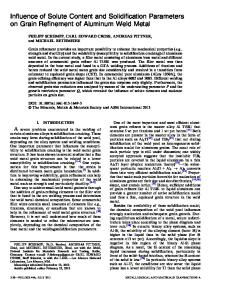Effect of Grain Refinement on the Dendrite Coherency Point during Solidification of the A319 Aluminum Alloy
- PDF / 607,114 Bytes
- 8 Pages / 593.972 x 792 pts Page_size
- 3 Downloads / 319 Views
CTION
DURING equiaxed dendritic solidification, the dendritic crystals are separate and can move freely in the early stage of the solidification process. With continuous growth of the dendritic crystals, the dendrite tips begin to impinge upon each other and their neighbors, so that a dendritic network is established throughout the solidifying volume. The term dendrite coherency point (DCP) refers to this point or stage.[1–3] The temperature, time, and volume fraction of solid at this point are called the coherency temperature, coherency time, and coherency fraction solid.[4,5] For some time, the DCP has been recognized as an important characteristic in cast aluminum alloys,[6–8] because it marks the transition from mass feeding to interdendritic feeding in the solidification process.[9,10] This means that the structural integrity of the dendritic network prohibits further mass feeding. Instead, the melt must flow through the solid network of the dendrites to feed solidification shrinkage.[3] Casting defects, such as macrosegregation, shrinkage porosity, and hot tearing formed during equiaxed dendritic growth, start to develop after DCP.[11] Thus, several authors have suggested that the coherency point may be an important indicator of alloy castability.[3,5,11] Therefore, a good understanding of solidification behavior at the DCP and the factors that affect the DCP is important. The techniques for determining the DCP can be classified in two main categories: the mechanical methods and the thermal analysis.[2] The mechanical methods are based on the assumption that the strength of the M. MALEKAN, Postdoctoral Student, and S.G. SHABESTARI, Professor, are with the Faculty of Materials and Metallurgical Engineering, Iran University of Science and Technology (IUST), Narmak, Tehran, Iran. Contact e-mail: [email protected] Manuscript submitted October 12, 2008. Article published online September 9, 2009 3196—VOLUME 40A, DECEMBER 2009
solidifying melt only begins to develop at the DCP. The DCP therefore is determined by a sharp increase in the shear strength. This is usually measured by torque change, using a paddle or a disc that is rotated in the melt at a constant rate.[1,2,4,5,11] The thermal analysis method uses the two-thermocouple technique developed by Ba¨ckerud et al.[1,2,6,7] One thermocouple is located at the center of a crucible and the other one at the inner wall. This technique is based on the assumption that the established dendritic network at the DCP will result in a rapid decrease in the temperature difference between the wall and the central regions, due to the higher thermal conductivity of the solid material compared with the liquid. The DCP is then determined by measuring the maximum point of the temperature difference. Recent investigations across a large range of aluminum alloys have reported that the fraction of solid at which dendrite coherency is reached varies systematically as a function of alloying composition, cooling rate, and grain refinement.[2,4,5,10–22] In the current work, a 319 aluminum alloy
Data Loading...











